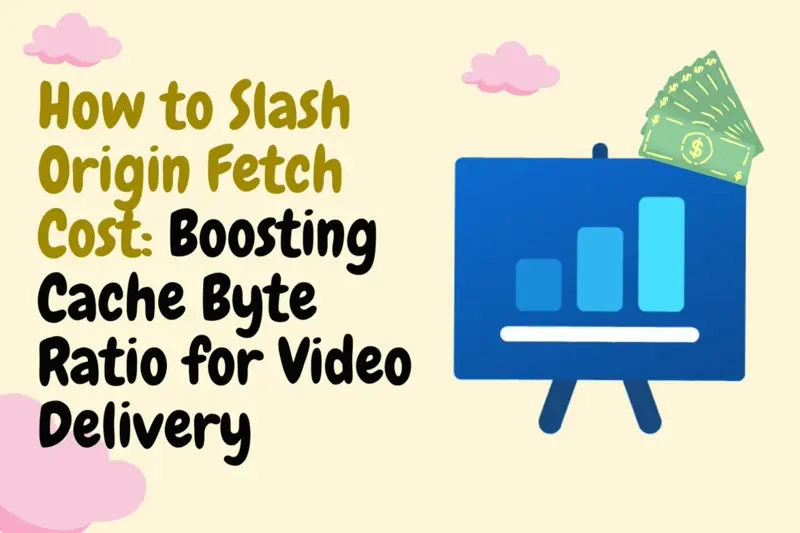How To Slash Origin Fetch Cost: Boosting Cache Byte Ratio For Video Delivery
Discover how shifting traffic from origin to cache lowers costs and improves video performance with faster starts and smoother playback.

Your dashboard is green, your viewers are happy, yet your cloud bill keeps climbing. The culprit is simple to explain and easy to miss. Most of your bytes still come from the origin. If you shift those bytes to the cache, you win twice.
Viewers get faster starts and smoother playback. You cut origin bandwidth cost and the spikes that wake you at night.
How Cache Byte Ratio Impacts Video Delivery
You care about bytes, not just requests. A small manifest and a large segment should not carry the same weight. Cache byte ratio measures the share of delivered bytes that come from cache. When this number goes up, two good things happen.
- You reduce egress from origin, which lowers direct fees and soft costs.
- You relieve compute at origin, which prevents scale out during peaks.
Use cache byte ratio as the main metric. Keep request hit ratio as a health signal. Tie both to video caching streaming workflows, since segments carry most of your traffic.
{{promo}}
Impact Of CBR On Origin Fetch Costs
Give yourself a clear model you can defend in a budget meeting. Keep the variables small and the math straight.
Variables
- (D): viewer delivery per day in gigabytes
- (c): egress price in dollars per gigabyte
- (CBR_0): current cache byte ratio as a decimal
- (CBR_1): improved cache byte ratio as a decimal
- (O_0 = D \times (1 - CBR_0)): origin bytes today
- (O_1 = D \times (1 - CBR_1)): origin bytes after improvement
- Daily egress savings (= (O_0 - O_1) \times c)
- Monthly egress savings (= 30 \times) daily egress savings
Add optional origin compute
- Let (m) be average miss rate by byte for segments
- Let (k) be average cost per miss in dollars, from CPU and packaging
- Daily compute savings (= m \times k \times) total segment requests served
If you do not know (m) or (k), track them for two weeks, then plug them in.
Worked scenarios
- A five point lift in cache byte ratio can cut origin bytes in half if you start above ninety percent.
- The dollar line maps one to one with byte savings. That is why cache byte ratio is the cleanest lever for origin fetch cost reduction.
How To Boost Cache Byte Ratio
Any successful change happens with monitoring, and careful planning, but there are several other steps you can take to improve your CBR.
1. Set Correct TTLs For VOD And Live
VOD is immutable and wants very long life, live manifests are pointers and must refresh quickly.
- What you change: long TTL for VOD manifests and segments, very short TTL for live manifests, long TTL for live segments.
- How to do it: use year long max age for VOD, use one to two seconds for live manifest when your segment is four to six seconds, use an hour or more for live segments to match the DVR window.
- How to prove it: segment hit rate climbs in every region, live start times stay stable, origin 206 volume drops.
2. Normalize Your Cache Key
Different URLs for the same segment cause cache fragmentation and misses.
- What you change: you remove noise from query strings and headers, keep only fields that change content.
- How to do it: ignore all query strings by default, allow only bitrate or language, exclude session tokens, do not vary on user agent, if you must split devices use a small custom label like mobile and desktop.
- How to prove it: your Top Miss URLs panel no longer shows the same segment with many parameters.
3. Enable Segmented Caching And Byte Range
The CDN fetches and reuses only the needed chunks, which raises cache byte ratio on large renditions.
- What you change: you turn on chunked object storage at the CDN and confirm the origin returns HTTP 206 for Range.
- How to do it: enable the feature on video paths, check that origin responds with 206 and Content Range, avoid applying it to HTML.
- How to prove it: fewer full origin transfers for segments, faster second viewer TTFB, higher byte offload for high bitrate tracks.
4. Choose Segment Duration That Helps The Cache
Very short segments raise request overhead, very long segments slow adaptation, a middle path helps both the cache and the player.
- What you change: you tune segment duration toward a balance that improves reuse without hurting start time.
- How to do it: test two and four second segments, align live manifest TTL to less than half of that, keep segment names consistent across qualities.
- How to prove it: request count drops, byte per request rises, cache byte ratio increases while startup stays steady.
5. Add A Shield Tier For Origin Protection
Many edges missing at once become one fetch at the shield, which protects the origin during peaks.
- What you change: you route all edge misses through a mid tier so only the shield can talk to origin.
- How to do it: pick a shield near your origin, enable tiered caching, keep the shield stable across regions, log its hit rate.
- How to prove it: origin request rate flattens during premieres, shield hit rate becomes your highest tier number.
6. Collapse Duplicate Fetches And Use Stale While Revalidate
One upstream fetch replaces many, while a short stale serve keeps the user from waiting.
- What you change: you let the CDN coalesce identical misses and you allow short staleness where safe.
- How to do it: enable request collapsing, add stale while revalidate to VOD assets, keep it short for live or skip it for the manifest.
- How to prove it: expiry windows stop causing latency spikes, origin spikes shrink, viewer rebuffer events fall.
7. Use Traffic Steering For Cost And Resilience
No single network is best in every city, steering raises cache locality and lowers blended rates.
- What you change: you steer sessions to the best path for price and quality, and you keep the shield common when possible.
- How to do it: run two CDNs, steer by region and success rate, add a cost dial for ties, keep sessions sticky through play, share a shield in front of your origin.
- How to prove it: regional cache byte ratio rises during launches, effective egress rate falls, failover tests keep playback stable.
8. Prefetch The Next Segments
The second viewer in a city often becomes a cache hit even at the live edge.
- What you change: you allow the edge or shield to pull the next segment early when the name pattern is clear.
- How to do it: fix naming so the CDN can see neighbors, keep prefetch depth small, prefer prefetch at the shield to reduce waste.
- How to prove it: hit rate at live edges improves, origin egress flattens during hot series drops.
9. Automate Live End Of Stream Purges
Stale live manifests confuse players and cause wasteful origin pulls.
- What you change: the encoder or scheduler calls the CDN purge API the instant a live event ends.
- How to do it: purge the exact path for the channel, batch purges if you run many channels, rate limit calls.
- How to prove it: late join errors drop, next event on the same channel starts clean.
{{promo}}
Top Video Delivery Cache Optimization Headers To Implement
Use these as defaults, then tune by workload.
Add this where safe on stable assets
stale-while-revalidate=60
Add this on origins that support ranges
Ensure Range requests return 206 with Content-Range.
Conclusion
You get the largest savings when you focus on bytes. Raise cache byte ratio on segments, keep live manifests fresh, collapse duplicate fetches, steer traffic with care, and keep a shield between the world and your origin.
This is video delivery cache optimization that you can roll out step by step. The result is less origin bandwidth cost, fewer late night pages, and happier viewers.
FAQs
Should I chase a perfect request hit ratio?
No. Requests do not map to spend. Keep watching it for health, but drive cache byte ratio for savings.
Is multi CDN with traffic steering always cheaper?
It is cheaper when you add session stickiness and a shared shield. Without that, you fragment the cache and pay more.
Can I skip byte range support at origin?
You can, yet you will move more whole files and lose chunk reuse. That raises egress and slows second viewer starts.
What segment duration should I start with?
Start at four seconds. Test two seconds if you need faster adaptation. Watch cache byte ratio and startup time as you tune.



.png)
.png)

.png)




